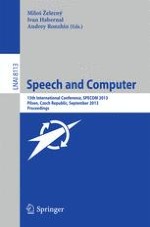This book constitutes the refereed proceedings of the 15th International Conference on Speech and Computer, SPECOM 2013, held in Pilsen, Czech Republic. The 48 revised full papers presented were carefully reviewed and selected from 90 initial submissions. The papers are organized in topical sections on speech recognition and understanding, spoken language processing, spoken dialogue systems, speaker identification and diarization, speech forensics and security, language identification, text-to-speech systems, speech perception and speech disorders, multimodal analysis and synthesis, understanding of speech and text, and audio-visual speech processing.
